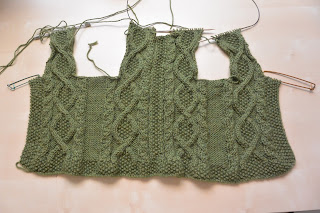A few weeks ago (actually, a few weeks before Thanksgiving) I was feeling like I had done a lot of apparel sewing this year and not enough quilting. I have fabric and pattern all ready to go for two or three lap to bed size quilts, but I was also feeling kind of overwhelmed with work and job-searching (I'm expecting to graduate in May), so I pulled out a Simply Color charm pack I've had sitting around for a while and the leftover grey background fabric from my Half Moon Modern Half-Square Triangle quilt and went to town with this free Moda pattern.
It took two evenings to piece the top. I didn't trim my HST units or pin any seams until I had all of the rows sewn together. It was quick and easy and fun, and really satisfying to get it done quickly, and I think it looks great - but it is decidedly not flat, which I'm feeling pretty okay about. I think it will quilt out just fine. I am not stressing out about this little baby quilt.
The problem came at the end of the second night of piecing, when I pulled out the fabric I had bought for backing and binding when I bought the charm pack. I only have one yard of the backing fabric. Lately I've been in a groove of making baby quilts about 40" by 50" and so I assumed that I would have 1.5 yards for the backing, but I don't. I don't have enough binding fabric to do anything but bind it (only 1/3 yard!) and I don't have any of the grey fabric left over. I think what I'm going to do is trim 4" of of the two wider borders on the top and then piece that fabric into the back along with a few leftover charm squares that didn't get used in the top.
I'm not really feeling inspired to finish this quilt right now, but at least I have a plan for how to finish it. I don't like to have long-term hibernating UFOs, but I also don't know of any babies who will be needing a quilt from me any time soon, so I think I'm going to piece the back and then fold it all up until I feel like finishing it.
Thursday, December 24, 2015
Sunday, December 13, 2015
Being a mathematician improves my knitting
Modular Arithmetic: This particular cardigan has an 18-row cable pattern that repeats several times beginning with row 9 of the sweater body, while at the same time you knit a buttonhole every tenth row beginning in row 5. So I know that I need to put a buttonhole in row 5, 15, 25, 35, and 45. I want to start counting my rows with row 1 of the CABLE PATTERN, so using the new numbering system for rows, I'll be putting buttonholes in row 7 (this is the second buttonhole), 17, 27, and 37. Then using modular arithmetic (also known as clock arithmetic) I reduce those modulo 18 and work buttonholes in rows 7, 17, 9, and 1 of the CABLE PATTERN. For me, this is much easier than trying to keep track of one count for the cable pattern and another for the buttonholes - instead, I just track everything in terms of the cable pattern.
Subscribe to:
Posts (Atom)


